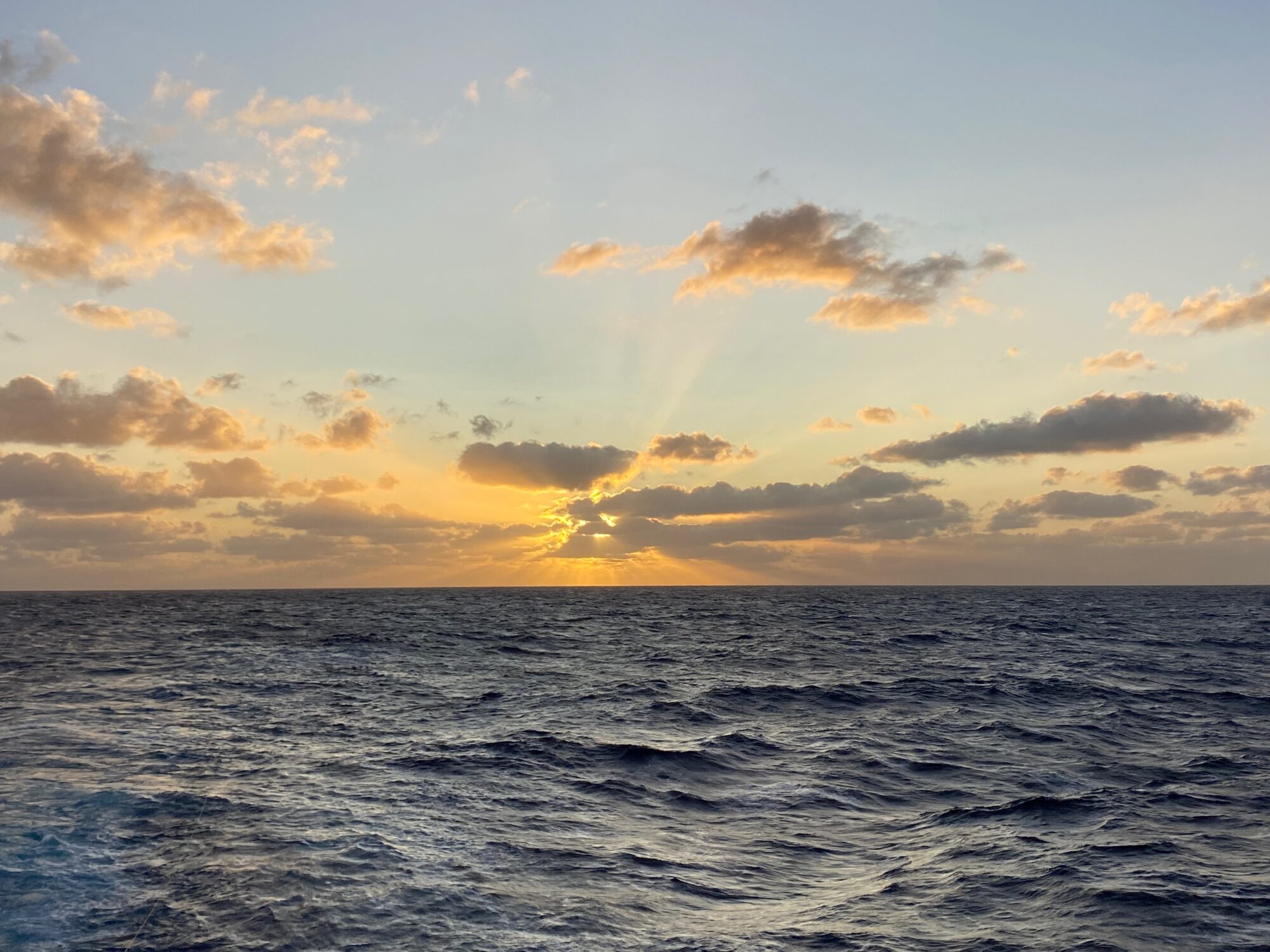-
Understanding metal isotope fractionation mechanism on various minerals
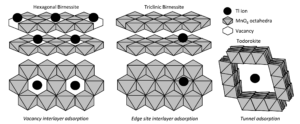 Manganese oxides are great scavengers of trace metals in the waters. How trace metals get removed from the water via sorption and whether there is fractionation occurring in this process play an important role in their marine mass balance. The various kinds of Mn oxide minerals in the natural environments also mean that metal sorption and isotope fraction behavior could vary significantly with Mn oxide mineralogy. We are using various lab synthesized Mn oxide minerals to investigate how Tl gets removed and (not) fractionated on the mineral surface (supported by NASA funding).
Manganese oxides are great scavengers of trace metals in the waters. How trace metals get removed from the water via sorption and whether there is fractionation occurring in this process play an important role in their marine mass balance. The various kinds of Mn oxide minerals in the natural environments also mean that metal sorption and isotope fraction behavior could vary significantly with Mn oxide mineralogy. We are using various lab synthesized Mn oxide minerals to investigate how Tl gets removed and (not) fractionated on the mineral surface (supported by NASA funding).
Relevant publications:
R. F. Phillips*, Y. Wang, F. Klein, G. Farfan, C. M. Ostrander, H. Gadol, C. M. Hansel, and S. G. Nielsen. The role of manganese oxide mineralogy in thallium isotopic fractionation upon sorption, 2023. Geochimica et Cosmochimica Acta, 356, 83-92, doi: 10.1016/j.gca.2023.07.011. (* student mentee).
-
Paleo-applications of novel stable metal isotope redox proxy
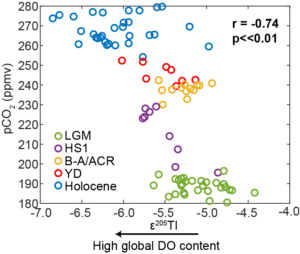 With new modern calibration of thallium isotopes, we have applied this proxy in multiple paleo-scenarios (Last Glacial Maximum, Oceanic Anoxic Event, to Mesoproterozoic). Newly funded NSF project will focus on the Penultimate Glacial Cycle, which aims to reconstruct both local and global ocean oxygen responses to glacial-glacial climate change. Other opportunities include Cenozoic sediments from the recent IODP 390/393 cruise.
With new modern calibration of thallium isotopes, we have applied this proxy in multiple paleo-scenarios (Last Glacial Maximum, Oceanic Anoxic Event, to Mesoproterozoic). Newly funded NSF project will focus on the Penultimate Glacial Cycle, which aims to reconstruct both local and global ocean oxygen responses to glacial-glacial climate change. Other opportunities include Cenozoic sediments from the recent IODP 390/393 cruise.
Funding:
NSF-OCE 2310174, PIs: Yi Wang (lead), Sune Nielsen, and Kassandra Costa, From local to global: deciphering oceanic oxygenation responses through the Penultimate Glacial Cycle ($688,078)
Post-Expedition Award for IODP 390: Lessons from past warm periods: preliminary study on oxygenation responses to climate change in Cenozoic ($19,938)
Relevant publications:
Y. Wang, K. M. Costa, W. Lu, Sophia K.V. Hines, and S. G. Nielsen. Global oceanic oxygenation controlled by the Southern Ocean through the last deglaciation, 2024. Science Advances.
A. Heard**, Y. Wang**, C. M. Ostrander, M. Auro, D. Canfield, S. Zhang, H. Wang, X. Wang, and S. Nielsen. Coupled vanadium and thallium isotope constraints on Mesoproterozoic ocean oxygenation around 1.38-1.39 Ga, 2023. Earth & Planetary Science Letters, 616, doi: 10.1016/j.epsl.2023.118127. (**co-first author)
Y. Wang, S. Bodin, J. S. Blusztajn, C. Ullmann, and S. G. Nielsen, 2022. Orbitally paced global oceanic deoxygenation decoupled from volcanic CO2 emission during the middle Cretaceous Oceanic Anoxic Event 1b (Aptian-Albian transition), Geology, doi: 10.1130/G50553.1.
-
Redox proxy validation
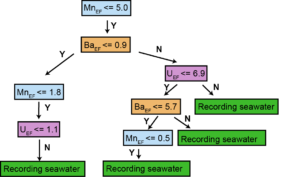 To identify appropriate redox proxies that minimize possible post-depositional overprints, modern proxy validation is required.
To identify appropriate redox proxies that minimize possible post-depositional overprints, modern proxy validation is required.
With a new set of core top materials, we are able to to directly compare the bottom water dissolved oxygen with geochemical proxies from sediments. We derived protocols for determining fidelity of sediment thallium isotopes (a proxy for global ocean oxygen content), improved marine thallium mass balance, and refined calibration for dissolved oxygen concentrations using benthic foraminifera porosity and sedimentary U/Ba. We also revisited fidelity of Fe speciation as a redox proxy with magnetic analyses on continental margin sediments.
Relevant publications:
K. M. Costa, S. G. Nielsen, Y. Wang, W. Lu, S. Hines, A. W. Jacobel, and D. W. Oppo. Marine sedimentary uranium to barium ratios as a potential quantitative proxy for Pleistocene bottom water oxygen concentrations, 2023. Geochimica et Cosmochimica Acta, 343, 1-16, doi: 10.1016/j.gca.2022.12.022.
Y. Wang, W. Lu, K. M. Costa, and S. G. Nielsen, 2022. Beyond anoxia: exploring sedimentary thallium isotopic compositions in paleo-redox reconstructions from a new core top collection, Geochimica et Cosmochimica Acta, 333, 347-361, doi: 10.1016/j.gca.2022.07.022.
W. Lu, Y. Wang, D. Oppo, S. G. Nielsen, and K. M. Costa, 2022. Comparing paleo-oxygenation proxies (benthic foraminiferal surface porosity, I/Ca, authigenic uranium) on modern sediments and glacial Arabian Sea, Geochimica et Cosmochimica Acta, 331, 69–85.
Y. Wang, I. Hendy, J. C. Latimer, D. Bilardello. Diagenesis and iron paleo-redox proxies: new perspectives from magnetic and iron speciation analyses in the Santa Barbara Basin, Chemical Geology, 519, 95-109, DOI: 10.1016/j.chemgeo.2019.04.018.
-
Understanding (natural/anthropogenic) driving mechanisms of oceanic oxygen by data-model comparison
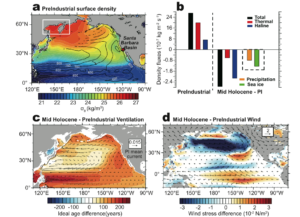 To investigate atmospheric teleconnections and oceanic oxygenation responses, we investigated the ocean oxygenation and compared the proxy data with state-of-the-art model (e.g., Community Earth System Model 1.2) results.
To investigate atmospheric teleconnections and oceanic oxygenation responses, we investigated the ocean oxygenation and compared the proxy data with state-of-the-art model (e.g., Community Earth System Model 1.2) results.
Relevant publications:
Y. Wang, I. Hendy, and J. Zhu. Extreme low-oxygen conditions in the early-to mid- Holocene associated with ventilation shifts in the Northeast Pacific, Quaternary Science Reviews, 238, doi:10.1016/j.quascirev.2020.106326.
Y. Wang, I. Hendy, and T. Napier. Climate and anthropogenic controls of coastal deoxygenation on interannual to centennial timescales, Geophysical Research Letters. 44, 11,528–11,536, DOI: 10.1002/2017GL075443
-
Nutrient cycling from nitrogen isotopes
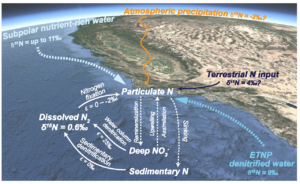
Relevant publications:
Y.Wang, I. Hendy, and R. Thunell. Local and remote forcing of denitrification in the Northeast Pacific for the last 2000 years. Paleoceanography and Paleoclimatology, 34, doi:10.1029/2019PA003577
